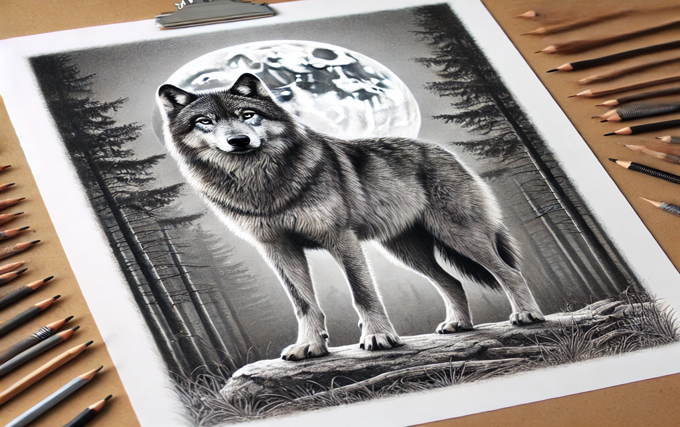Drawing animals can be both a challenging and rewarding experience for artists of all levels. Among the myriad of creatures to depict, wolves hold a special allure. Their majestic presence, complex anatomy, and the rich symbolism they carry make them fascinating subjects. This article will delve into the intricacies of Drawing:el5lvtvvu6c= wolf, providing a detailed exploration of techniques, styles, and tips to help you create stunning wolf illustrations.
Understanding the Wolf: An Overview
Before putting pencil to paper, it’s essential to understand the animal you’re drawing. Wolves are social animals known for their pack behavior, keen senses, and striking physical features. Here are some key characteristics of wolves that you should consider when drawing:
Physical Characteristics
- Anatomy: Wolves possess a strong, muscular build with long legs, broad heads, and powerful jaws. Their bodies are designed for endurance and agility, making them excellent hunters.
- Fur: The texture and coloration of a wolf’s fur can vary widely. Common colors include shades of gray, brown, black, and white. The fur is typically dense and can appear different depending on the season.
- Eyes: Wolves have piercing eyes that can range from yellow to amber. Their eyes convey emotion and intelligence, which can add depth to your drawings.
Symbolism and Cultural Significance
Wolves are often associated with various symbolic meanings across different cultures. They can represent loyalty, guardianship, intelligence, and freedom. Understanding these themes can help you infuse your artwork with deeper meaning.
Materials Needed for Drawing:el5lvtvvu6c= wolf
To create a stunning wolf drawing, you’ll need the right materials. Here’s a list of essential supplies:
1. Pencils
A range of pencils (from H to B grades) will allow you to create varying levels of shading and detail.
2. Paper
Choose a quality drawing paper that can handle erasing and layering. Bristol board or sketch paper is a great option.
3. Erasers
Both a kneaded eraser and a regular vinyl eraser will be useful for correcting mistakes and blending.
4. Blending Tools
Tortillons or blending stumps can help achieve smooth gradients in your shading.
5. Reference Images
Having quality reference images of wolves will guide your drawing and ensure accuracy.
Step-by-Step Guide to Drawing a Wolf
Step 1: Gather Reference Material
Start by collecting a variety of wolf images. Look for pictures that show different poses, angles, and fur textures. Pay attention to the wolf’s anatomy, focusing on the head, body, and limbs.
Step 2: Basic Shapes
Begin with light pencil strokes to sketch basic shapes that outline the wolf’s body. Use circles for the head and joints, and ovals for the body and limbs. This step helps establish the proportions and overall structure.
Step 3: Define the Outline
Once you’re satisfied with the basic shapes, start refining the outline of the wolf. Pay attention to the curves and angles of the body, head, and legs. Ensure that the features are accurate and proportionate.
Step 4: Add Facial Features
Focus on the wolf’s face, which is one of the most expressive parts of the animal. Draw the eyes, ears, and snout with attention to detail. Wolves have distinct, angular features that convey strength and intelligence.
Step 5: Sketch the Fur
Start adding texture to the fur. Use short, quick strokes to mimic the direction of hair growth. Pay attention to the layering of fur, especially around the neck and face, where it may be denser.
Step 6: Add Shading and Depth
Using your range of pencils, begin shading the wolf. Determine the light source in your drawing and apply darker shades where shadows would naturally occur. Blend these areas to create depth and dimension.
Step 7: Refine and Detail
Review your drawing and refine any areas that need more detail or correction. Pay attention to the eyes, adding highlights to make them appear lifelike. Incorporate finer details in the fur and any other prominent features.
Step 8: Final Touches
Once you’re happy with the overall look, add any final touches. This may include enhancing contrast, cleaning up lines, or adding background elements.
Exploring Different Drawing Styles
Wolves can be represented in various artistic styles, each conveying a unique feel and message. Here are some popular styles to consider:
Realism
Realistic wolf drawings aim to capture the true essence of the animal. This style requires attention to detail, accurate anatomy, and lifelike textures. Artists often use reference photos to ensure accuracy.
Abstract
Abstract art allows for creative freedom. In this style, you can represent a wolf using geometric shapes, bold colors, and exaggerated features. This approach encourages experimentation and can result in striking visual interpretations.
Cartoon
Cartoon wolves often embody playful characteristics. This style typically simplifies features and exaggerates expressions, making it suitable for illustrations aimed at children or comedic contexts.
Surrealism
Surrealistic drawings can blend elements of reality and fantasy. You might depict a wolf in an unusual setting or incorporate imaginative elements, such as unusual colors or dream-like features.
Tips for Improving Your Wolf Drawings
1. Practice Regularly
Consistent practice is key to improving your drawing skills. Set aside time each week to sketch wolves in various poses and styles.
2. Study Anatomy
Understanding animal anatomy will greatly enhance your ability to draw them accurately. Consider studying wolf anatomy specifically to understand muscle structure and movement.
3. Experiment with Different Mediums
While pencils are excellent for drawing, don’t hesitate to experiment with other mediums like charcoal, ink, or digital tools. Each medium offers unique possibilities for expression.
4. Seek Feedback
Share your work with fellow artists or in online communities. Constructive feedback can provide valuable insights and help you identify areas for improvement.
5. Be Patient
Drawing can be challenging, and progress takes time. Don’t rush the process; enjoy each stage of your drawing journey.
Conclusion
Drawing:el5lvtvvu6c= wolf is an enriching experience that combines technical skill with creative expression. By understanding their anatomy, practicing regularly, and exploring different styles, you can create impressive wolf illustrations that capture their beauty and essence. Whether you choose to draw realistically or experiment with abstract styles, remember that the journey of improvement is just as important as the final artwork. So grab your pencils, find some inspiration, and let your creativity run wild as you embark on the adventure of Drawing:el5lvtvvu6c= wolf.


